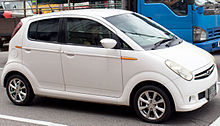
Summary
The Subaru R2 is a kei car produced and sold in Japan by Fuji Heavy Industries from 2003 to 2010. Its name was inspired by the Subaru R-2, produced from 1969 to 1972. The R2 was discontinued in 2010.
| Subaru R2 | |
|---|---|
 | |
| Overview | |
| Production | 2003–2010 |
| Assembly | Japan: Ōta, Gunma (Ōta plant) |
| Body and chassis | |
| Class | Kei car |
| Body style | 5-door hatchback |
| Related | Subaru R1 |
| Powertrain | |
| Engine | 658 cc (40.2 cu in) EN07U Inline 4 658 cc (40.2 cu in) EN07D DOHC AVCS Inline 4 658 cc (40.2 cu in) EN07X DOHC Inline 4 supercharged (STi) |
| Transmission | 5-speed manual iCVT |
| Dimensions | |
| Wheelbase | 2,360 mm (92.9 in) |
| Length | 3,395 mm (133.7 in) |
| Width | 1,475 mm (58.1 in) |
| Height | 1,520 mm (59.8 in) |
| Curb weight | 880 kg (1,940.1 lb) |
| Chronology | |
| Predecessor | Subaru R-2 (spiritually) Subaru Pleo (first generation) |
| Successor | Subaru Lucra Subaru Pleo (second generation) |


Design edit
The R2 was the first production Subaru to sport a new family look, including the aviation-inspired "spread wings grille"[1] also used by their Tribeca and Impreza.
The R2's exterior dimensions are largely similar to its predecessor, the Subaru Pleo; but unlike the squarish Pleo, the R2 has a deliberately rounded, less space-efficient form.
Three variations of the 4-cylinder 658 cc engine were available:
- SOHC
- DOHC AVCS (variable valve timing)
- DOHC with supercharger and intercooler (R2 STi)
Unlike other Subaru models which used Boxer engines, the R2 used an inline engine.
The two lower engine options were available with either a manual transmission or a CVT. The supercharged engine was coupled to a sportshift version of the CVT ("7 speed iCVT"). Both front wheel drive and all wheel drive were available.
Initially, the R2 was available in 11 colors and 3 trim levels (one for each engine variation).
On January 4, 2005, the Subaru R1 was introduced, which was a 2-door version of the R2 with a shorter body and wheelbase.
In 2006, the R2 got a facelift, replacing its spread wings grille with one similar to the Subaru Legacy.
In popular culture edit
The Subaru R2 is a playable secret car in the arcade video game Wangan Midnight Maximum Tune.
References edit
- ^ Dan Neil (October 31, 2007). "Soft-serve Subie". Los Angeles Times. Retrieved 2008-04-11.


